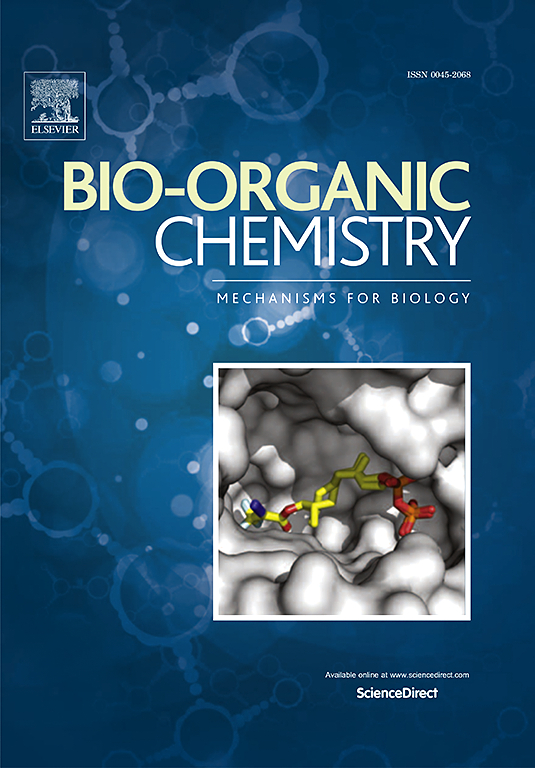Golgi-targeted ratiometric fluorescent probe: Precise detection of H2S level fluctuations under stress conditions and acute liver injury
IF 4.5
2区 医学
Q1 BIOCHEMISTRY & MOLECULAR BIOLOGY
引用次数: 0
Abstract
Hydrogen sulfide (H₂S), as an important endogenous gas messenger molecule, changes in its concentration are closely related to oxidative stress and inflammatory responses of cells, which makes H₂S play a key regulatory role in acute liver injury. In order to precisely track the dynamic changes of H₂S in a liver injury model, a novel ratiometric fluorescent probe, NF-FOH, was developed in this study based on aminoquinoline derivatives, which possesses excellent assay properties, such as high sensitivity (10.4 nM), high specificity, and fast response (10 min), as well as Golgi targeting properties and favorable biosafety. These properties enable NF-FOH to achieve portable detection of H₂S via test strips and localization analysis of H₂S in the Golgi. In addition, NF-FOH can effectively detect endogenous H₂S in aspirin-induced and ferroptilized HeLa cells, and can be used to monitor the fluctuation of H₂S levels in cellular, zebrafish, and mouse models of acute liver injury, which provides a powerful tool for in-depth study of the mechanism of H₂S in cellular physiology and pathological processes.

高尔基靶比例荧光探针:精确检测应激条件和急性肝损伤下H2S水平波动
硫化氢(H₂S)作为一种重要的内源性气体信使分子,其浓度的变化与细胞的氧化应激和炎症反应密切相关,这使得H₂S在急性肝损伤中起着关键的调节作用。为了精确跟踪肝损伤模型中H₂S的动态变化,本研究基于氨基喹啉衍生物研制了一种新型比例荧光探针NF-FOH,该探针具有高灵敏度(10.4 nM)、高特异性、快速响应(10 min)、高尔基靶向性和良好的生物安全性等优良的检测特性。这些特性使NF-FOH能够通过试纸和高尔基体中H₂S的定位分析实现H₂S的便携式检测。此外,NF-FOH可有效检测阿司匹林诱导和铁化HeLa细胞内源性H₂S,并可用于监测细胞、斑马鱼和小鼠急性肝损伤模型中H₂S水平的波动,为深入研究H₂S在细胞生理病理过程中的作用机制提供有力工具。
本文章由计算机程序翻译,如有差异,请以英文原文为准。
求助全文
约1分钟内获得全文
求助全文
来源期刊

Bioorganic Chemistry
生物-生化与分子生物学
CiteScore
9.70
自引率
3.90%
发文量
679
审稿时长
31 days
期刊介绍:
Bioorganic Chemistry publishes research that addresses biological questions at the molecular level, using organic chemistry and principles of physical organic chemistry. The scope of the journal covers a range of topics at the organic chemistry-biology interface, including: enzyme catalysis, biotransformation and enzyme inhibition; nucleic acids chemistry; medicinal chemistry; natural product chemistry, natural product synthesis and natural product biosynthesis; antimicrobial agents; lipid and peptide chemistry; biophysical chemistry; biological probes; bio-orthogonal chemistry and biomimetic chemistry.
For manuscripts dealing with synthetic bioactive compounds, the Journal requires that the molecular target of the compounds described must be known, and must be demonstrated experimentally in the manuscript. For studies involving natural products, if the molecular target is unknown, some data beyond simple cell-based toxicity studies to provide insight into the mechanism of action is required. Studies supported by molecular docking are welcome, but must be supported by experimental data. The Journal does not consider manuscripts that are purely theoretical or computational in nature.
The Journal publishes regular articles, short communications and reviews. Reviews are normally invited by Editors or Editorial Board members. Authors of unsolicited reviews should first contact an Editor or Editorial Board member to determine whether the proposed article is within the scope of the Journal.
 求助内容:
求助内容: 应助结果提醒方式:
应助结果提醒方式:


